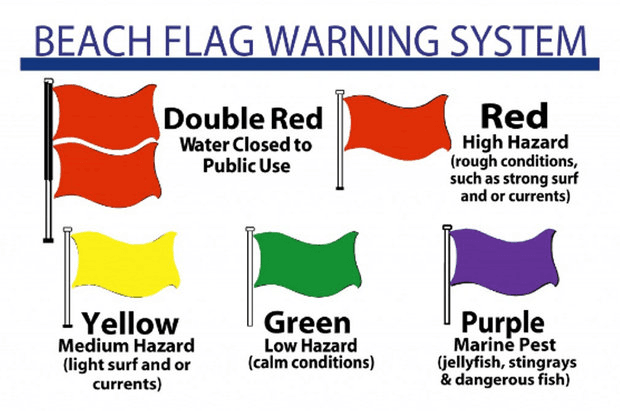

For many, the summer time marks countless days spent relaxing at the beach. Laying in the sun, building sand castles, and of course swimming in the ocean are some well known pastimes enjoyed by beachgoers. However, safety precautions cannot be forgotten while enjoying a day at the beach, especially when it comes to swimming in the ocean or riding some nice waves on a surfboard. Tides and Rip Currents are two factors that have an effect on swimmer's safety, and will be discussed below.
So let's discuss what tides are and how they form. A tide is defined as the alternating rise and fall of the ocean (though tides can occur in rivers and lakes, too). This rise and fall is caused by the gravitational pull of the Moon on Earth, as well as Earth's rotational force. High tide is when water advances to its farthest extent on the shoreline and occurs on the side of Earth closest to the moon. Since this side of Earth most strongly experiences the Moon's gravitational pull, the Earth's surface bulges and water's rise, forming a higher tide. However, high tides also form on the side of Earth directly opposite/facing away from the Moon. Here, the rotational force of Earth is strongest while the Moon's gravitational force is weakest, causing seas to rise as well. Elsewhere on Earth, the ocean recedes to its farthest extent on the shoreline, therefore creating low tides.

The sun does play a role, though its quite minor in comparison to the Moon's effect. When the Earth, Moon, and Sun all line up (which occurs during a full moon or new moon) more extreme high and low tides can occur. These are called Spring or "King" tides, which occur every two weeks across our oceans.

Typically, shorelines experience two high tides and two low tides within a period just over 24 hours. This is how long it takes the Moon to completely rotate once around the Earth. The height of tides is largely affected by the shoreline's physical shape and geographic features.
When going to the beach, it's important to take into account the safest times for swimming and enjoying the water with respect to the ocean's tides. Tidal currents accompany tides, which are the horizontal movement of water to and from the coast. Water moves towards the coast in a flood tidal current during a high tide, while water moves away from the coast in an ebb tidal current during a low tide.
Flood and ebb currents are the strongest at or around the peak of high or low tide, making this the most difficult and dangerous time for beachgoers to swim in the water (especially during flood tide). Meanwhile, the water is safest when tidal currents are the weakest, or during a slack tide, which happens in the hour preceding or following a high or low tide.
During this time, the water moves very little, and waves are calmer and less dangerous. Current tide info for various locations along the East Coast can be found here to provide for safe beachgoing this summer.
Rip currents are an additional ocean hazard that can threaten the safety of beachgoers headed to the water for a nice swim. They are powerful, narrow channels of fast-moving water that move away from the shoreline and extend from close to the shoreline through the surf and past the breaking waves. Strong rip currents can actually travel at speeds faster than an Olympic swimmer! They are hidden dangers at the beach because they can pull swimmers farther away from the shore when they least expect it. Unfortunately, there are around 100 rip current fatalities across the country each year, with around 80% of all ocean rescues at the beach being rip current related.
When headed to the beach, it is extremely important to have knowledge on what rip currents look like and how to spot them in the water.
It is easiest to spot rip currents from an elevated position overlooking the beach, as they are typically found in areas where waves are not breaking. Additionally, rip currents may look darker, muddy, or choppier than the surrounding ocean waters.
Checking water conditions the day before heading out to the beach is extremely important, especially for swimmers. So make sure to view your local beach forecast before headed out. While we think of rip currents happening from storms or offshore hurricanes, they can happen all year long. Just because the weather is forecasted to be nice, doesn't mean rip currents can't occur. In fact, they quite frequently form on nice, sunny days. Additionally, always be sure to swim with lifeguards present, as the chances of drowning at a beach with lifeguards present are only 1 in 18 million.
Be sure to know what warning flags mean at the beach as well. A green flag indicates water conditions are safe for swimmers, while other flag colors mean conditions are unsafe for swimming. See the image below for more clarification on the types of beach warning flags.

Finally, be sure to know what to do if you find yourself in a rip current. In case you accidentally become caught in one, here is the biggest takeaway:
DO NOT try and swim directly to the shore while in the rip current, as the current's speed and force will bring you further out to sea and use up your energy. Instead, swim along the shoreline until you can escape the current's pull, then swim at angle away from the current and toward the shore.
Sources:
National Geographic: https://www.nationalgeographic.org/encyclopedia/tide/
Swim Guide: https://www.theswimguide.org/2020/02/13/what-tide-is-best-for-your-favourite-water-activity/
National Weather Service: https://www.weather.gov/safety/ripcurrent